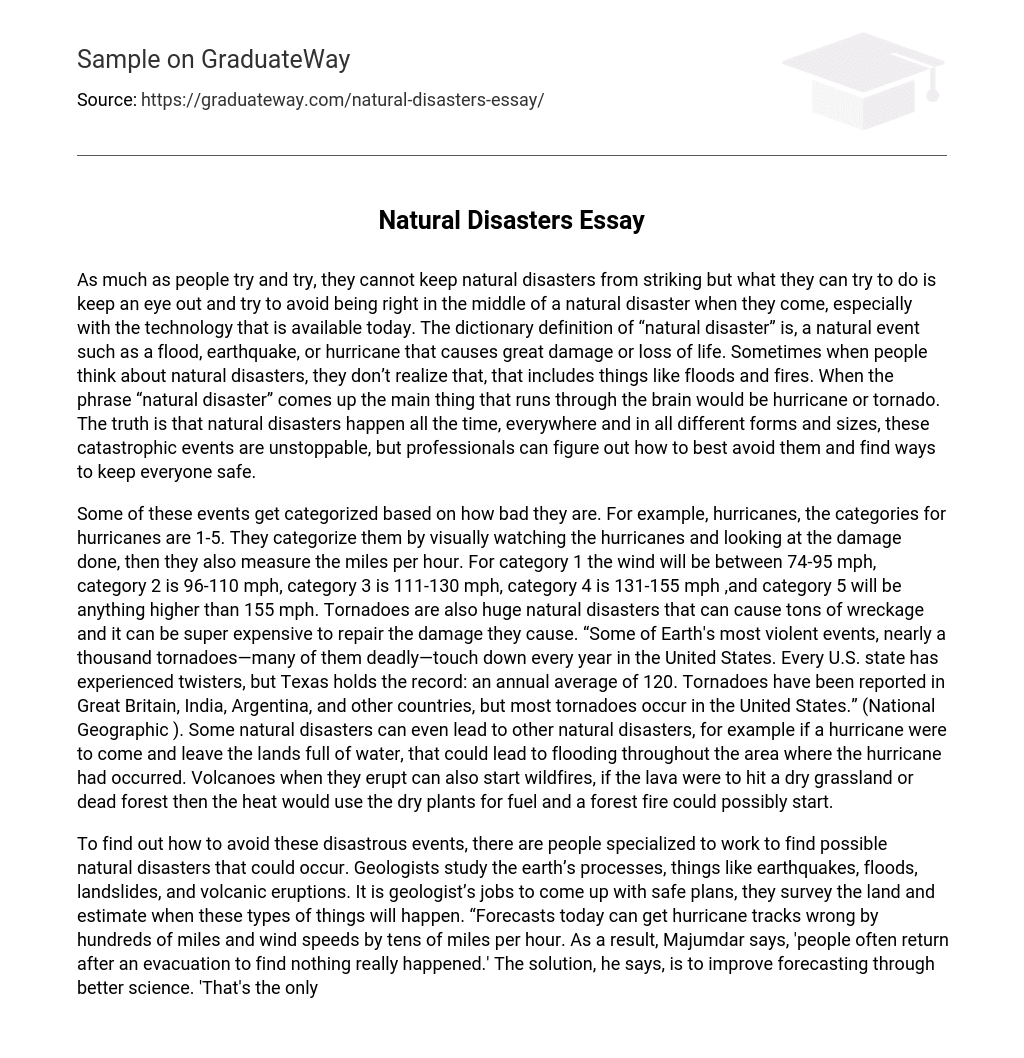As much as people try and try, they cannot keep natural disasters from striking but what they can try to do is keep an eye out and try to avoid being right in the middle of a natural disaster when they come, especially with the technology that is available today. The dictionary definition of “natural disaster” is, a natural event such as a flood, earthquake, or hurricane that causes great damage or loss of life. Sometimes when people think about natural disasters, they don’t realize that, that includes things like floods and fires. When the phrase “natural disaster” comes up the main thing that runs through the brain would be hurricane or tornado. The truth is that natural disasters happen all the time, everywhere and in all different forms and sizes, these catastrophic events are unstoppable, but professionals can figure out how to best avoid them and find ways to keep everyone safe.
Some of these events get categorized based on how bad they are. For example, hurricanes, the categories for hurricanes are 1-5. They categorize them by visually watching the hurricanes and looking at the damage done, then they also measure the miles per hour. For category 1 the wind will be between 74-95 mph, category 2 is 96-110 mph, category 3 is 111-130 mph, category 4 is 131-155 mph ,and category 5 will be anything higher than 155 mph. Tornadoes are also huge natural disasters that can cause tons of wreckage and it can be super expensive to repair the damage they cause. “Some of Earth’s most violent events, nearly a thousand tornadoes—many of them deadly—touch down every year in the United States. Every U.S. state has experienced twisters, but Texas holds the record: an annual average of 120. Tornadoes have been reported in Great Britain, India, Argentina, and other countries, but most tornadoes occur in the United States.” (National Geographic ). Some natural disasters can even lead to other natural disasters, for example if a hurricane were to come and leave the lands full of water, that could lead to flooding throughout the area where the hurricane had occurred. Volcanoes when they erupt can also start wildfires, if the lava were to hit a dry grassland or dead forest then the heat would use the dry plants for fuel and a forest fire could possibly start.
To find out how to avoid these disastrous events, there are people specialized to work to find possible natural disasters that could occur. Geologists study the earth’s processes, things like earthquakes, floods, landslides, and volcanic eruptions. It is geologist’s jobs to come up with safe plans, they survey the land and estimate when these types of things will happen. “Forecasts today can get hurricane tracks wrong by hundreds of miles and wind speeds by tens of miles per hour. As a result, Majumdar says, ‘people often return after an evacuation to find nothing really happened.’ The solution, he says, is to improve forecasting through better science. ‘That’s the only way to get people to trust the warnings.’ (National Geographic). Better technology is always being invented, forcing out old technology, as these new gadgets get better and better, geologist’s predictions get better and better and overall people are safer, and less likely to evacuate a city unnecessarily.
It can be crazy to think about how most these events happen naturally, hence the name, natural disasters, but wildfires, unlike most other natural disasters are commonly started by people. “Between 2000 and 2012, natural disasters caused $1.7 trillion in damage and affected 2.9 billion people.” (11 Facts About Disasters). The damage done can be so much work. Sometimes people lose their homes, sometimes pets and sometimes even lives are lost. The surrounding areas after a disaster like this happens, are often left destroyed and take tremendous amounts of work and effort put in by everyone to help repair it and get it back as it was. “In 2012 there were 905 natural catastrophes worldwide including severe storms, droughts, tornadoes, earthquakes, floods, hail storms, typhoons, wildfires, and hurricanes.” (11 Facts About Disasters). These disasters are everywhere and they are inevitable but as people work together as a whole, things are able to get done and these events are easier to predict and easier to escape.
Natural disasters have tremendous effects on the environments around them and all the people and home and communities. The scariest thing about them is that they are unavoidable and they can be there one minute then be gone the next like tornadoes or lighting. They are categorized by their strength and size, 1 being the smallest or weakest all the way up to 5 being the strongest. Geologists try their best to track them and hunt them down to try to see where they will strike and meteorologists will provide you with that information through the news, social media or even newspapers! After they hit, sometimes the areas are unrepairable and people can even go missing. After hurricanes or tornadoes often times lots of debris is left behind covering things up, leaving people searching for lost items for months.





